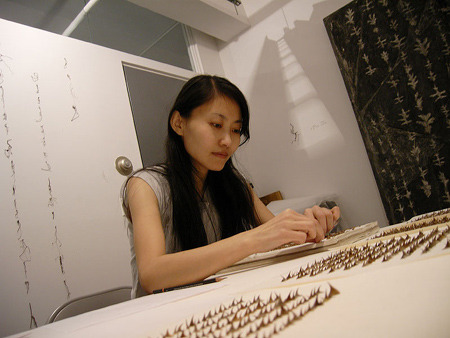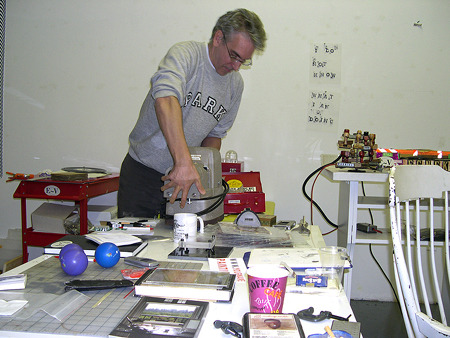
The Business of Art: “The Artist’s Guide to Grant Writing”
Neil Reilly on Gigi Rosenberg’s The Artist’s Guide to Grant Writing
Gigi Rosenberg began her career as an artist before she even knew it. By convincing her parents to buy her a film camera during a childhood summer, she used planning and persuasion skillsthat she would later recognize as crucial to maintaining a career in art. With her own story in mind, she set out to write The Artist’s Guide to Grant Writing: How to Find Funds and Write Foolproof Proposals for the Visual, Literary, and Performing Artist, and in the process succeeded in putting herself in the shoes of her readers and providing for them the most important and relevant information they need to succeed as working artists.
The book begins by hammering home a crucial point: to be successful, an artist must promote his or her work and support it financially. Money in support of art is out there to be had; funders donate to artists because they have an explicit desire to do so, not for the sake of charity. Grant writing is thus a major method of raising money, and writing a winning grant proposal is a mandatory skill for all artists.
In The Artist’s Guide to Grant Writing, Rosenberg takes the reader by the hand to navigate the fundraising process, demystifying many of the daunting components that line the road to funding. She begins by explaining exactly what a grant is: money given away by the government, corporations, or private foundations to fund a project, sometimes with stipulations regarding its use, but other times unrestricted. Rosenberg then describes the various types of grants that exist, each designed to help artists with specific goals related to their needs.
The grant writing process is time-consuming, and to effectively communicate one’s concepts for a project, one must examine one’s own career goals and current needs, and the steps that must be taken to meet them. Rosenberg provides examples of ways to stay organized and on schedule, set aside a time to conduct research on available grants, engage friends and colleagues for advice and cooperation along the way, and think outside the box regarding possible sources of funding. Rather than being a mind-numbing chore, the process of writing a grant proposal can lend greater focus to one’s work.
Rosenberg pays particular attention to the importance of having a helpful team for support, encouragement, and criticism during the process. She encourages getting partners for research, brainstorming, preparing to speak with funders, proofreading and editing one’s work, and assisting with compiling work samples. Partners can help in honing concepts and steering the direction of budding projects.
The Artist’s Guide to Grant Writing tackles the physical components of the application process, including the letter of inquiry, the cover letter, the executive summary, the narrative project description, the artist bio/résumé, the artist statement, the project budget, work samples and descriptions, supplementary materials, timelines, and letters of recommendation. The basic information about each of these components is presented with a clear sense of what funders expect in an application. Crucially, Rosenberg stresses the need to follow an application’s instructions, even if it seems like a “Kafka-esque” process. She also suggests ways to form a well-rounded narrative by answering implicit questions, such as “How is your project tried and true?” and “Why does the world need your project right now?”

Image: Ken Montgomery, NYFA Fellow in Electronic Arts, in his studio
The well-written proposal narrative will make a project jump to life from the page. Expect to write a terrible first draft, Rosenberg says, but do not be afraid of making mistakes. Subsequent drafts will help fill holes that exist in the narrative and, if necessary, will expose gaps in the project itself. She offers helpful tips to strengthen one’s writing, such as, “Write in the future tense,” “Use the funder’s terminology,” and, “Don’t overuse adjectives.” As always, get another pair of critical eyes to assist with editing.
Artists should take a step back during the application process and analyze the situation through the eyes of the funder. Because a proposal will be tailored to a specific foundation or organization, the outlook, funding priorities, and selection criteria of the target audience must be accounted for. By asking demanding questions of oneself, one’s project will be more solid, and a proposal will exude a sense of confidence that will set it apart from the competition.
Expressing oneself in a single-page format can be difficult, but Rosenberg offers the keys to writing what is often required on grant applications: the artist statement (“It’s what you, the artist, express and understand about why you do what you do”); the artist bio (a narrative about oneself, including birthplace and education); and the résumé (a list of training and work history relevant to the application).
The book’s strongest chapters are those that cover work samples and budgeting. Rosenberg stresses the importance of using a professional to photograph one’s work, and to beware of technical glitches when preparing electronic work samples. When creating a budget, be as specific as possible; the line items, like a narrative, tell the story of your project, and funders are only interested in supporting projects that seem stable and viable.
The Artist’s Guide to Grant Writing also addresses aspects of fundraising that venture beyond grant writing. Rosenberg touches on alternative income sources such as in-kind gifts (goods or services donated by an organization), fundraising events (studio or house parties), and merchandising (selling CDs or copies of work, for example). She details the importance of befriending funders, and having a prepared “elevator speech” to pitch oneself or one’s project in a handful of sentences. Keeping engaged with funders, even (and, for edifying purposes, especially) those who do not fund a project, is an important step toward gaining confidence and maintaining a good relationship going forward.
The book concludes with useful appendices to guide readers on the grant writing journey, including a helpful list of websites to search for discipline-specific funding opportunities. Following the appendix, Rosenberg references other grant writing guidebooks, some of which can also be found online. Finally, she offers up some important resources for artists, ranging from financial planning to psychological support services. Rosenberg’s ability to relate to artists across disciplines, coupled with her experience as a professional development coach and teacher, has resulted in a book that will certainly serve as an important resource for those whose seek to support themselves through their creative work.
Gigi Rosenberg will be discussing and signing copies of The Artist’s Guide to Grant Writing: How to Find Funds and Write Foolproof Proposals for the Visual, Literary, and Performing Artist at the New York City Barnes & Noble at 86th Street and Lexington Avenue on March 31 at 7 p.m.
As Institutional Giving Officer at NYFA, Neil Reilly writes grant proposals to raise funds from government, corporations and foundations. He is a musician and writer and lives in Brooklyn.